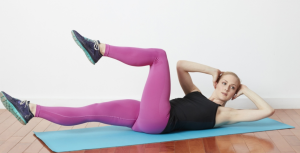Exploring the Health Benefits of Exercise and Movement
 This article discusses the possible health benefits of exercise and movement. One of the most obvious differences between modern life and life in the past can be found in the level of exercise. For the majority of people living in developed countries today, heavy physical exercise does not occur as a part of ordinary daily life, but must be deliberately sought out. Compare this to most of human history, in which heavy daily exercise was a requirement for survival. Even among the upper classes in 19th century Europe—to judge by a scene in Charles Dickens Pickwick Papers—going for a 10 to 20 mile walk by way of recreation was not be out of the ordinary course of events.
This article discusses the possible health benefits of exercise and movement. One of the most obvious differences between modern life and life in the past can be found in the level of exercise. For the majority of people living in developed countries today, heavy physical exercise does not occur as a part of ordinary daily life, but must be deliberately sought out. Compare this to most of human history, in which heavy daily exercise was a requirement for survival. Even among the upper classes in 19th century Europe—to judge by a scene in Charles Dickens Pickwick Papers—going for a 10 to 20 mile walk by way of recreation was not be out of the ordinary course of events.
The human body was designed to use its physical capacities. However, for many of us, life has become a sedentary affair, moving from couch via car to office cubicle. While decreasing strenuous exercise does have some benefits, such as reducing injuries, it also presents major drawbacks. Inadequate exercise is undoubtedly a major contributor to the current epidemic of obesity, which in turn leads to diabetes, heart disease, and osteoarthritis.
Conversely, increasing one’s level of exercise provides a wide variety of benefits. Besides enhancing strength and endurance and improving physical attractiveness, exercise is thought to enhance overall health as well as reduce symptoms in a number of specific ailments. However, while the many benefits of exercise appear self-evident, they can be quite difficult to provein a scientific sense. The primary problem comes down to this: it is difficult, if not impossible, to design a double-blind study of exercise.
In a double-blind, placebo-controlled study, neither patients nor researchers know who is receiving a real treatment and who is receiving a placebo.
Consider the following scenario: A study (technically, an observational or epidemiological study) may note that people in a given population who exercise more develop heart disease at a lower rate than those who exercise less. From this, it is tempting to conclude causality: that exercise reduces heart disease risk. But such a conclusion might not be correct.
Observational studies only show association, not cause and effect. Studies of the type described above had long shown that women who used hormone replacement therapy (HRT) were less likely to develop heart disease. Furthermore, use of HRT was known to improve cholesterol profile. It seemed like a “slam-dunk” case. However, to researchers’ surprise, when a giant double-blind study compared hormone replacement therapy against a placebo, the results showed that use of HRT actually increased heart disease risk.
It is now hypothesized that this apparent contradiction may be due to the fact that women who use HRT are generally of higher socioeconomic status than women who do not use HRT, and that it is this socioeconomic status, and not the HRT, that was responsible for the apparent benefits seen. Whatever the reason, it is now clear that HRT does not prevent heart disease, and that the conclusions drawn from observational studies were exactly backwards. Based on this, one must at least consider the possibility that people who engage in more exercise have other qualities that protect them from heart disease, and that it is these qualities, and not the exercise, that protects them. The problem here is that while it is possible to give a placebo that convincingly resembles HRT, it is difficult to conceive of a placebo form of exercise that patients and researchers wouldn’t immediately identify as different from real exercise.
Besides observational studies, other forms of scientific research involving exercise remain similarly inadequate. For example, consider the numerous studies that have been taken as proving that exercise is helpful for depression . In these studies, people who are made to exercise improve to a greater extent than those who are not interfered with. However, this finding does not prove that exercise per se aids depression. It might be, for example, that simply being enrolled in a study and motivated to do anything at all might aid depression. (This suspicion is given further weight by findings that improvement in depression is not at all related to the intensity of the exercise done—if it were the exercise itself, one would think that more intense exercise would provide greater benefits.)
Double-blind, placebo-controlled studies eliminate all of these potential confounding factors, as well as many others. However, as noted above, it is not feasible to design a double-blind study in which people are unaware (“blind” to the fact ) that they are exercising. Therefore, all results regarding the potential benefits of exercise must be taken with a grain of salt.
Regular Exercise: How to Get Started
Where do I start?
Since brisk walking qualifies as moderately intense physical activity, that is a place to start if you are new to exercise. Before starting an exercise program, check with your doctor about any possible medical problems you may have that would limit your exercise program.
Consider making an appointment with a certified athletic trainer to help you develop a safe, effective, and enjoyable exercise program. You can find a trainer at a local gym or through a referral from your doctor or a friend. Make sure this person understands your goals and can help you maintain an exercise program that you will enjoy and stick with.
How much exercise do I need?
National health and exercise organizations recommend you do moderately intense physical activity for at least 30 minutes on most (preferably all) days of the week. Doing more vigorous exercise is also encouraged.
What kinds of exercise should I do?
To offer you the full range of benefits, your exercise program should include the major categories of exercise–aerobic (cardiovascular exercise), strength training (resistance exercises), and flexibility (stretching exercise). Within all of these major categories of exercise, there are a number of different options (see below).
Aerobic (Cardiovascular) Exercise
In aerobic exercise, you continually move large muscles in the legs and buttocks. This action causes you to breathe more deeply and your heart to work harder to pump blood, thereby strengthening your heart and lungs.
Examples include:
- Walking
- Jogging
- Running
- Aerobic dance
- Bicycling
- Swimming
- Hiking
- Playing sports that involve running, such as basketball and soccer
Strength Training (Resistance) Exercise
Strength training builds lean muscle mass, which increases your physical strength and your bone mass.
Examples include:
- Weight lifting, using:
- Free weights
- Weight machines
- Elastic tubing
- Calisthenics, such as push ups or chin ups
Flexibility (Stretching) Exercise
Stretching can offer many benefits, such as improving:
- Flexibility
- Range of motion
- Circulation
Major muscle groups to stretch include:
- Back muscles
- Neck muscles
- Leg muscles: hamstrings, quadriceps, calf muscles
- Chest muscles
- Buttocks and hip muscles
- Shoulder and arm muscles
- Stomach muscles
Stretching classes include:
Here are some tips for safe stretching:
- Spend at least 5-10 minutes warming up your muscles before stretching. For example, walking gently while swinging your arms in wide circles.
- Start each stretch slowly, exhaling as you gently stretch the muscle.
- Hold each stretch for 10-30 seconds.
Here are some common stretching mistakes to avoid:
- Do not bounce during a stretch.
- Do not stretch a muscle that is not warmed up.
- If a stretch hurts, ease up. Do not strain or push a muscle too far.
- Do not hold your breath while stretching.
Join Our Community
Archives
- January 2023
- December 2022
- September 2022
- August 2022
- June 2022
- May 2022
- April 2022
- March 2022
- February 2022
- January 2022
- December 2021
- November 2021
- October 2021
- September 2021
- August 2021
- July 2021
- June 2021
- May 2021
- March 2021
- September 2020
- August 2020
- July 2020
- June 2020
- May 2020
- April 2020
- March 2020
- February 2020
Subscribe

Sign up to receive FREE toolkit
From Dr. Hyman, #1 NY Times & Amazon Author
We never spam or sell your e-mail









Follow Our Every Move